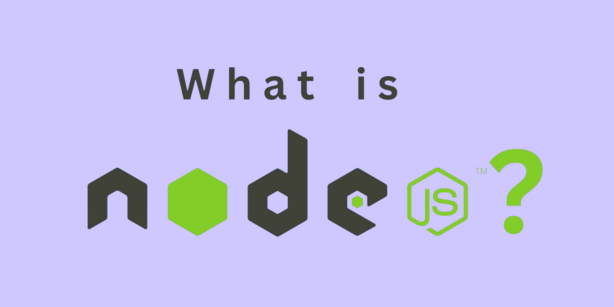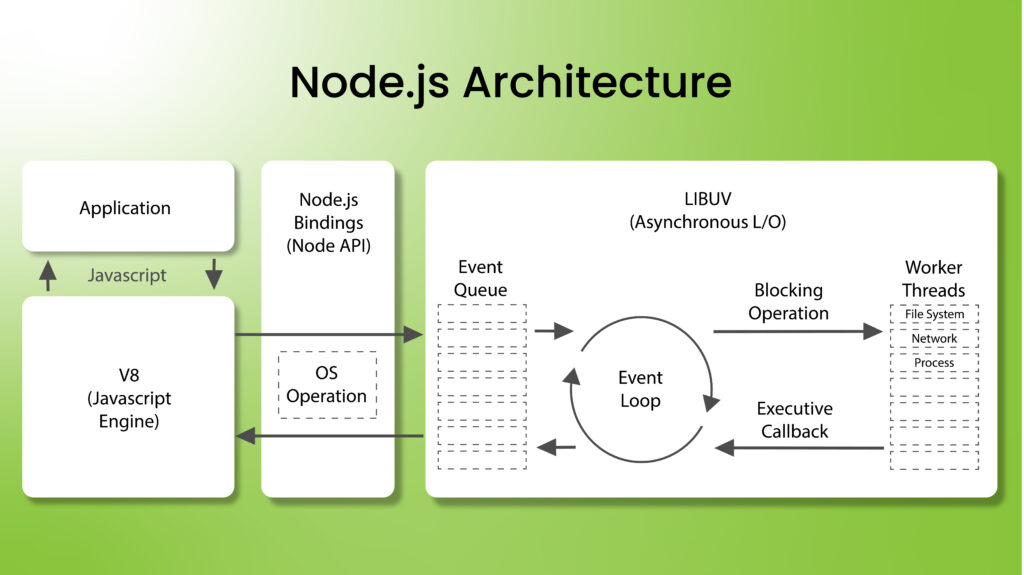Fundamental Tutorials of Node.js
What is Node.js?

Node.js is an open-source, cross-platform runtime environment that runs on the V8 JavaScript engine. It is designed to build scalable network applications. Node.js is event-driven and non-blocking, which makes it efficient at handling concurrent requests. Node.js is a popular choice for building real-time web applications, such as chat applications and streaming applications. It is also used for building server-side applications, such as web APIs and microservices.
Here are some of the key features of Node.js:
- Event-driven: Node.js is event-driven, which means that it only executes code when an event occurs. This makes it efficient at handling concurrent requests.
- Non-blocking: Node.js is non-blocking, which means that it does not block the main thread when it is waiting for an event to occur. This makes it efficient at handling concurrent requests.
- Cross-platform: Node.js is cross-platform, which means that it can run on Windows, macOS, and Linux.
- Asynchronous: Node.js is asynchronous, which means that it can handle multiple requests at the same time.
- Scalable: Node.js is scalable, which means that it can be easily scaled to handle more requests.
What are the top use cases of Node.js?
Node.js is a popular runtime environment that is used for a wide variety of applications.
Here are some of the top use cases of Node.js:
- Real-time web applications: Node.js is a popular choice for building real-time web applications, such as chat applications and streaming applications. This is because Node.js is event-driven and non-blocking, which makes it efficient at handling concurrent requests.
- Server-side applications: Node.js is also used for building server-side applications, such as web APIs and microservices. This is because Node.js is asynchronous, which means that it can handle multiple requests at the same time.
- IoT applications: Node.js is used for building IoT applications, as it can be used to handle the high volume of data that is generated by IoT devices.
- Content management systems: Node.js is used for building content management systems (CMSs), such as WordPress and Drupal. This is because Node.js is scalable and can handle a large number of users.
- E-commerce: Node.js is used for building e-commerce websites, as it can handle the high volume of traffic that is generated by e-commerce websites.
- Logistics: Node.js is used for building logistics applications, such as tracking shipments and managing inventory levels. This is because Node.js is scalable and can handle a large number of transactions.
- Financial: Node.js is used for building financial applications, such as trading platforms and risk management systems. This is because Node.js is scalable and can handle a large number of transactions.
- Healthcare: Node.js is used for building healthcare applications, such as electronic medical records (EMRs) and patient portals. This is because Node.js is scalable and can handle a large number of users.
What are the features of Node.js?
Node.js is a popular runtime environment that is used for a wide variety of applications.
Here are some of the key features of Node.js:
- Event-driven: Node.js is event-driven, which means that it only executes code when an event occurs. This makes it efficient at handling concurrent requests.
- Non-blocking: Node.js is non-blocking, which means that it does not block the main thread when it is waiting for an event to occur. This makes it efficient at handling concurrent requests.
- Cross-platform: Node.js is cross-platform, which means that it can run on Windows, macOS, and Linux.
- Asynchronous: Node.js is asynchronous, which means that it can handle multiple requests at the same time.
- Scalable: Node.js is scalable, which means that it can be easily scaled to handle more requests.
- JavaScript: Node.js is based on JavaScript, which is a popular programming language that is easy to learn and use.
- Ecosystem: Node.js has a large and active ecosystem, which means that there are a wide variety of modules and libraries available for Node.js.
What is the workflow of Node.js?
Here are some additional details about each step:
- Creating a project: The first step is to create a project. This can be done by creating a new directory and initializing it with the npm init command. The npm init command will prompt you to enter a few basic details about your project, such as the name of the project and the version number.
- Installing dependencies: The next step is to install the dependencies for your project. This can be done by running the npm install command. The npm install command will install the dependencies that are listed in the package.json file.
- Writing code: The next step is to write the code for your project. This code will be executed by the Node.js runtime environment. The Node.js runtime environment is a JavaScript engine that is designed to execute JavaScript code on the server.
- Running the code: The code can be run by executing the node command. The node command will execute the JavaScript code that is contained in the file.
- Testing the code: The code can be tested by using a variety of testing frameworks, such as Mocha and Chai. Testing frameworks are used to automate the testing of code.
- Deploying the code: The code can be deployed to a production environment by using a variety of deployment methods, such as Heroku and Amazon Web Services (AWS). Deployment is the process of making the code available to users.
How Node.js Works & Architecture?

Node.js is an open-source, cross-platform runtime environment that runs on the V8 JavaScript engine. It is designed to build scalable network applications. Node.js is event-driven and non-blocking, which makes it efficient at handling concurrent requests. Node.js works by using a single-threaded event loop to handle all of the requests that are made to the server. The event loop is responsible for calling the appropriate callbacks when events occur. Events can be triggered by a variety of things, such as HTTP requests, file system changes, and timer events.
The Node.js architecture is divided into two main parts: the event loop and the modules. The event loop is responsible for handling all of the requests that are made to the server. The modules are responsible for providing functionality to the Node.js runtime environment. The event loop is a critical part of the Node.js architecture. It is responsible for making sure that all of the requests that are made to the server are handled in a timely manner. The event loop is also responsible for making sure that the Node.js runtime environment is not blocked by anyone’s request.
The modules are a key part of the Node.js architecture. They provide functionality to the Node.js runtime environment, such as HTTP request handling, file system access, and database access. The modules are written in JavaScript and can be installed using the npm package manager.
Node.js is a powerful and versatile platform that is used for a wide variety of applications. It is a good choice for applications that require scalability, efficiency, and versatility.
Here are some of the key features of the Node.js architecture:
- Single-threaded event loop: The Node.js event loop is a single-threaded event loop. This means that only one request can be processed at a time. However, the event loop is non-blocking, which means that it can handle multiple requests in parallel.
- Modules: Node.js modules are a key part of the architecture. They provide functionality to the Node.js runtime environment, such as HTTP request handling, file system access, and database access.
- JavaScript: Node.js is based on JavaScript. This makes it easy to learn and use, and there is a large and active community of JavaScript developers.
How to Install and Configure Node.js?
Here are the steps on how to install and configure Node.js:
- Download the Node.js installer. You can download the Node.js installer from the official Node.js website.
- Install the Node.js installer. The installation process will vary depending on your operating system.
- Configure the Node.js environment variables. You will need to configure the Node.js environment variables so that you can run Node.js applications from the command line.
- Verify the installation. You can verify the installation by running the node -v command.